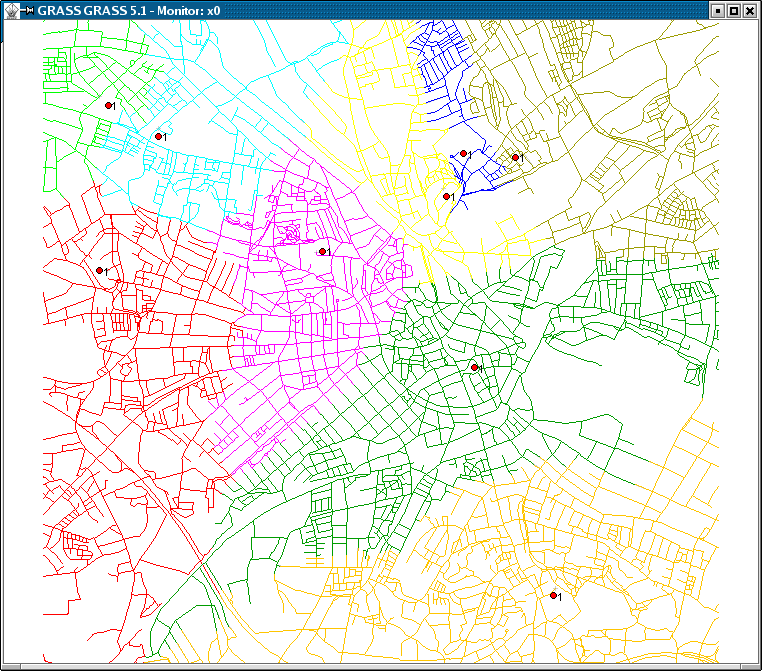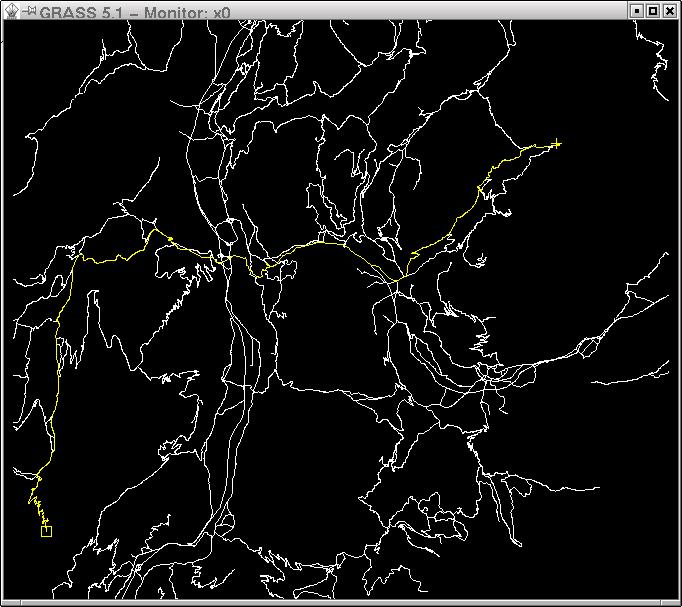Vector network analysis/pl: Difference between revisions
Jump to navigation
Jump to search

v.net.iso - Split net to bands between cost isolines (direction from centre). Costs of centre node are used in calculation. 
v.net.alloc - Allocates subnets for nearest centres (direction from centre). Costs of centre node are used in calculation. 
d.path - Find shortest path for selected starting and ending node.
m (pl translation) |
m (pl translation) |
||
| Line 8: | Line 8: | ||
* Utrzymanie sieci: {{cmd|v.net|version=70}} | * Utrzymanie sieci: {{cmd|v.net|version=70}} | ||
* Najkrótsza | * Najkrótsza trasa: {{cmd|d.path|version=64}} and {{cmd|v.net.path|version=70}} | ||
* Najkrótsza | * Najkrótsza trasa pomiędzy wszystkimi parami punktów: {{cmd|v.net.allpairs|version=70}} | ||
* | * Wyznaczanie podsieci (tworzenie podsieci, np. police station zones): {{cmd|v.net.alloc|version=70}} | ||
* Jednakowe odległości (ze środków): {{cmd|v.net.iso|version=70}} | * Jednakowe odległości (ze środków): {{cmd|v.net.iso|version=70}} | ||
* Computes bridges and articulation points: {{cmd|v.net.bridge|version=70}} | * Computes bridges and articulation points: {{cmd|v.net.bridge|version=70}} | ||
* Computes degree, centrality, betweeness, closeness and eigenvector centrality measures: {{cmd|v.net.centrality|version=70}} | * Computes degree, centrality, betweeness, closeness and eigenvector centrality measures: {{cmd|v.net.centrality|version=70}} | ||
* | * Obliczanie dobrze i słabo połączonych komponentów: {{cmd|v.net.components|version=70}} | ||
* Computes vertex connectivity between two sets of nodes: {{cmd|v.net.connectivity|version=70}} | * Computes vertex connectivity between two sets of nodes: {{cmd|v.net.connectivity|version=70}} | ||
* | * Obliczanie najkrótszej drogi w sieci pomiędzy zadanymi zestawami obiektów: {{cmd|v.net.distance|version=70}} | ||
* | * Obliczanie maksymalnego przepływu pomiędzy dwoma zestawami punktów: {{cmd|v.net.flow|version=70}} | ||
* Computes minimum spanning tree: {{cmd|v.net.spanningtree|version=70}} | * Computes minimum spanning tree: {{cmd|v.net.spanningtree|version=70}} | ||
* Minimum | * Minimum drzewa Steinera (star-like connections, e.g. broadband cable connections): {{cmd|v.net.steiner|version=70}} | ||
* Znajdowanie najkrótszej drogi z użyciem rozkładów jazdy: {{cmd|v.net.timetable|version=70}} | * Znajdowanie najkrótszej drogi z użyciem rozkładów jazdy: {{cmd|v.net.timetable|version=70}} | ||
* | * Analizy komiwojażera (round trip): {{cmd|v.net.salesman|version=70}} | ||
Vector directions are defined by the digitizing direction (a-->--b). You can navigate either omnidirectionally or differently in each directions as both directions are supported. Network modules provide parameters to assign attribute columns to the forward and backward direction. To see how a vector is directed, use the "display" parameter of {{cmd|d.vect}} (set display=dir). | Vector directions are defined by the digitizing direction (a-->--b). You can navigate either omnidirectionally or differently in each directions as both directions are supported. Network modules provide parameters to assign attribute columns to the forward and backward direction. To see how a vector is directed, use the "display" parameter of {{cmd|d.vect}} (set display=dir). | ||
| Line 57: | Line 57: | ||
[[Category:Documentation]] | [[Category:Documentation]] | ||
[[Category:Vector]] | [[Category:Vector]] | ||
[[Category:Languages/pl]] | |||
Revision as of 11:53, 10 September 2012
Vector network analysis
GRASS provides support for vector network analysis using the DGlib Directed Graph Library.
Zaimplementowane algorytmy
Poniższe algorytmy są zaimplementowane (w GRASS 6.5+):
- Utrzymanie sieci: v.net
- Najkrótsza trasa: d.path and v.net.path
- Najkrótsza trasa pomiędzy wszystkimi parami punktów: v.net.allpairs
- Wyznaczanie podsieci (tworzenie podsieci, np. police station zones): v.net.alloc
- Jednakowe odległości (ze środków): v.net.iso
- Computes bridges and articulation points: v.net.bridge
- Computes degree, centrality, betweeness, closeness and eigenvector centrality measures: v.net.centrality
- Obliczanie dobrze i słabo połączonych komponentów: v.net.components
- Computes vertex connectivity between two sets of nodes: v.net.connectivity
- Obliczanie najkrótszej drogi w sieci pomiędzy zadanymi zestawami obiektów: v.net.distance
- Obliczanie maksymalnego przepływu pomiędzy dwoma zestawami punktów: v.net.flow
- Computes minimum spanning tree: v.net.spanningtree
- Minimum drzewa Steinera (star-like connections, e.g. broadband cable connections): v.net.steiner
- Znajdowanie najkrótszej drogi z użyciem rozkładów jazdy: v.net.timetable
- Analizy komiwojażera (round trip): v.net.salesman
Vector directions are defined by the digitizing direction (a-->--b). You can navigate either omnidirectionally or differently in each directions as both directions are supported. Network modules provide parameters to assign attribute columns to the forward and backward direction. To see how a vector is directed, use the "display" parameter of d.vect (set display=dir).
- see the vectorintro "vector map processing and network analysis" help page
Example: Shortest path routing
- zobacz strony opisujące v.net.path i d.path
Nowe pomysły
- Vector network analysis ideas (pomóż w realizacji)
Zrzuty ekranu
- more screenshots from the GRASS website



See also
- GSoC Network Analysis: many new modules!